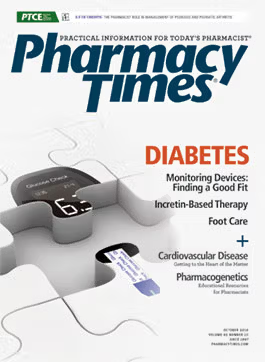Publication
Article
Pharmacy Times
Zembrace SymTouch
Author(s):
The FDA has approved Zembrace Symtouch subcutaneous injection for the acute treatment of migraine with or without aura in adult patients.
The FDA has approved Zembrace Symtouch (sumatriptan succinate; by Promius Pharma) subcutaneous injection for the acute treatment of migraine with or without aura in adult patients. The approval carries the limitation that the product should be used only if a clear diagnosis of migraine has been established and that it is not indicated for prophylactic migraine management.1 Zembrace SymTouch is supplied in a prefilled 2-step autoinjector. The subcutaneous route of administration may provide rapid pain relief and be a preferred medication delivery route for patients who experience nausea, vomiting, or other gastric disturbances during their migraines.2
PHARMACOLOGY AND PHARMACOKINETICS
Zembrace SymTouch is a serotonin receptor agonist. It binds with high affinity to human cloned 5-HT1B/1D receptors. The product’s effect is thought to result from agonist activity at the 5-HT1B/1D receptors on intracranial blood vessels and sensory nerves of the trigeminal system, leading to cranial vessel constriction and inhibition of proinflammatory neuropeptide release.
After a 3-mg subcutaneous dose, Zembrace SymTouch was found to be bioequivalent to Imitrex subcutaneous injection. The mean time to peak concentration of a 6-mg dose was 12 minutes, with a range of 5 to 20 minutes. Age, race, or mild to moderate hepatic impairment do not affect the pharmacokinetics of Zembrace SymTouch.1
DOSAGE AND ADMINISTRATION
Zembrace SymTouch should be given as a single 3-mg subcutaneous injection at the onset of an acute migraine. A maximum of 12 mg may be given in a 24-hour period, with each 3-mg dose separated by at least 1 hour.1
CLINICAL TRIALS
One single-attack, parallel-group design clinical trial compared 6 different doses of Zembrace SymTouch to placebo to determine the dose-response relationship. The trial found that after a 3-mg subcutaneous dose, 17% of patients using Zembrace SymTouch experienced pain relief at 10 minutes, 47% at 30 minutes, 57% at 1 hour, and 60% at 2 hours.
Two randomized, placebo-controlled trials of 1104 patients with moderate to severe migraine pain found that 70% of the patients using Zembrace SymTouch 6 mg experienced headache relief within 1 hour of dose administration. After 2 hours, approximately 82% of the Zembrace SymTouch patients experienced pain relief and approximately 65% were pain-free. The Zembrace SymTouch group also reported relief of photophobia, phonophobia, nausea, and vomiting associated with migraine.1
CONTRAINDICATIONS, WARNINGS, AND PRECAUTIONS
Zembrace SymTouch is contraindicated in patients with a history of coronary artery disease, coronary vasospasm, stroke, transient ischemic attack, hemiplegic migraine, or basilar migraine. The product is contraindicated in patients with Wolff-Parkinson-White syndrome or other cardiac accessory conduction pathway disorders, peripheral vascular disease, ischemic bowel disease, uncontrolled hypertension, use of another 5-HT1 agonist or ergotamine-containing medication within the past 24 hours, concurrent use of a monoamine oxidase-A inhibitor or use of one within the past 2 weeks, hypersensitivity to sumatriptan, or severe hepatic impairment.
Patients with multiple cardiovascular risk factors should have a cardiac evaluation prior to initiation of treatment. Zembrace SymTouch should be discontinued if arrhythmias occur. Chest, throat, neck or jaw pain, tightness, pressure, or heaviness may occur during treatment and is usually not associated with myocardial ischemia; however, high-risk patients should be evaluated for coronary artery disease. Zembrace SymTouch should be discontinued if cerebral hemorrhage, subarachnoid hemorrhage, stroke, gastrointestinal ischemia, or peripheral vasospastic reactions occur. Detoxification may be necessary if medication overuse headache occurs. Zembrace SymTouch should be discontinued if serotonin syndrome occurs. The product should be used cautiously in patients with epilepsy or a lowered seizure threshold. Zembrace SymTouch is in Pregnancy Category C.
The most common adverse reactions of Zembrace SymTouch (occurring in ≥5% of patients and with greater incidence than for patients taking placebo) were injection-site reactions, tingling, dizziness or vertigo, warm or hot sensations, burning sensations, a feeling of heaviness, pressure sensation, flushing, a feeling of tightness, and numbness.1
Dr. Holmberg earned her PharmD from the University of Connecticut and completed an ambulatory care residency at the Phoenix VA Healthcare System. Her practice has also included pediatrics and inpatient mental health. She resides in Phoenix, Arizona.
References
- Zembrace SymTouch [package insert]. Princeton, NJ: Promius Pharma; January 2016.
- FDA approved Zembrace SymTouch (sumatriptan injection) 3 mg in January 2016 for the acute treatment of migraine with or without aura in adults.
- Zembrace SymTouch is now commercially available in the US [press release]. Promius Pharma website. promiuspharma.com/wp-content/uploads/2016/04/Zembrace_NowAvailable_PressRelease_Promius-FINAL.pdf. Accessed August 2016.







